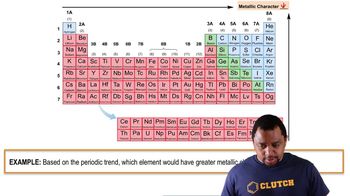Here are the essential concepts you must grasp in order to answer the question correctly.
Ionization Energy
Ionization energy is the energy required to remove an electron from an atom in its gaseous state. It generally increases across a period from left to right due to increasing nuclear charge, which holds electrons more tightly. Conversely, it decreases down a group as the outer electrons are further from the nucleus and experience more shielding from inner electrons.
Recommended video:
Metallic Character
Metallic character refers to the tendency of an element to exhibit properties typical of metals, such as conductivity, malleability, and ductility. It increases down a group in the periodic table and decreases across a period from left to right. This trend is due to the increasing ability of elements to lose electrons and form positive ions.
Recommended video:
Metallic Character Example
Anions and Their Formation
Anions are negatively charged ions formed when an atom gains one or more electrons. Nonmetals, particularly those in groups 15, 16, and 17 of the periodic table, commonly form anions. For example, sulfur (S) can gain two electrons to form a 2- anion (S^2-), which is essential for understanding the reactivity and bonding behavior of elements.
Recommended video:
 Verified step by step guidance
Verified step by step guidance

